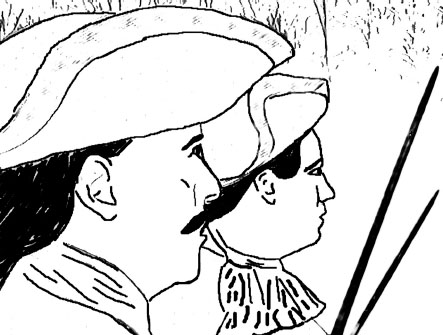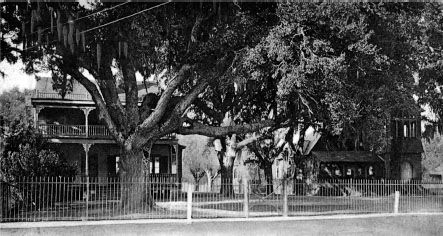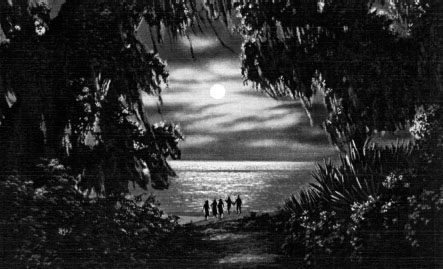Legends and Lore of the Mississippi Golden Gulf Coast (4 page)
Read Legends and Lore of the Mississippi Golden Gulf Coast Online
Authors: Edmond Boudreaux Jr.

Only five men knew the location. This party of five would make its way to New Orleans and finally to Grand Terre on Barataria Bay. Here Lafitte had Dr. Delmand make a poison, “a little of which would kill without exciting suspicion.” He had Dr. Delmand set sail the next day. When Dr. Delmand returned, he learned that the two crew members who buried the treasure chest had suddenly died, but no one seemed concerned. Things appeared to be getting back to normal. This respite lasted only until, during a quarrel, Grampo accused Lafitte of being a murderer. At this point, Lafitte shot Grampo. Now only Jean Lafitte and Dr. Delmand knew the treasure's location.
In 1814, the United States fleet attacked the pirates' stronghold at Barataria. Lafitte escaped to Galveston Bay and Dr. Delmand to New Orleans. Caught by surprise, many were captured and their vessels seized.
Dr. Delmand practiced medicine in New Orleans for many years. His fear of being recognized as a pirate eventually forced a move to the small town of Ocean Springs. The dying Dr. Delmand was very weak when he confessed this tale to Dr. Herbert but told him that a paper hidden beneath one of the bricks in the hearth would disclose his former identity and reveal the spot where the chest was buried. At this point, his wife entered the room, and Dr. Delmand lost consciousness and died that evening. Dr. Herbert returned the next day and told Mrs. Delmand the story and asked permission to search for the paper. She at first objected but then finally agreed. They found the loose brick, but no paper was beneath it.
Dr. Herbert felt Mrs. Delmand had found the paper after overhearing her husband's confession. “Not long after Dr. Delmand's death, his house rapidly burned to the ground one night.” Mrs. Delmand died in that fire. In the newspaper article, Schuyler Poitevent indicated that the story had been told several years ago and that Dr. Herbert had died since then.
Schuyler at first did not believe the story, but recent events of 1896 made him reconsider. On Sand Island in Alabama he had found Spanish coins, and the lighthouse keeper told him that he also had found Spanish coins. The keeper said that a Spanish wreck was nearby. Also, a shipwreck had been discovered in Biloxi Bay, four hundred yards from the beach where two magnolia trees stood, one with a boat carved on it. On the wreck were cannons, guns and cutlasses. Schuyler closed his article with him standing on the deck of the salvage ship looking at the artifacts. “This must have been the
L'Hirondelle
and Dr. Delmand must have told the truth. I wonder who will find the chest?”
So far, our story has ended with the treasure undiscovered and the question of whether it is fact or fiction. Since Schuyler was twenty-one when he wrote the article, by his own account he would have been about fourteen years old when he heard Dr. Herbert's story. As far as Dr. Herbert, Dr. Delmand or Baptiste Fountaine, none is listed in the 1800s censuses of Jackson or Harrison Counties, but that is not to say they are not real individuals encountered by the young Schuyler Poitevent or the Poitevent family.

Jean Lafitte, the “Pirate Lord” of the Gulf of Mexico, and his brother, Pierre.
Edmond Boudreaux
.
Sand Island, Alabama, could be the site where a Spanish ship wrecked, but no battle between Lafitte and Spanish vessels was recorded in this area. One battle that sounds similar to this one occurred off Omoa, Honduras, in 1823. Supposedly, Lafitte attacked two Spanish vessels. Both were disguised military vessels that turned and counterattacked Lafitte. When he realized his mistake, he turned his vessel and retreated. He was supposedly wounded in this skirmish and later died from his wounds. His remains were buried at sea, but there are many rumors and legends that he lived to fight another day.
What about Jean Lafitte's vessel
L'Hirondelle
that was lost in Biloxi Bay? No reference to a vessel by that name can be found with ties to Jean Lafitte. Schuyler did not name Lafitte's brother in his article, but Lafitte's brother Pierre was Lafitte's second in command.
What of Jean Lafitte's first lieutenant, Grampo? Jean Lafitte had two first lieutenants, Dominique Youx and Renato Beluche. Dominique Youx was born in 1775 and died on November 15, 1830, in New Orleans. He is buried in the Saint Louis Cemetery Number 2. His tombstone claims his valor on the sea and at the Battle of New Orleans in 1815. He is believed to be the half-brother of Jean and Pierre Lafitte. Renato Beluche was born in New Orleans in 1773. He also fought at the Battle of New Orleans next to Dominique Youx. Both were cited by General Andrew Jackson for their abilities in battle. Neither was called Grampo, who supposedly was killed in 1813.
What about the sunken vessel in Biloxi Bay? We know that the vessel Schulyer refers to is a French vessel lost in the early 1700s. It was discovered in 1893 by the Tiblier family, and cannons, powder, cutlasses and guns were recovered. The cannons from this wreck are located on the south side of Highway 90 in Biloxi's War Memorial Park, north of the Small Craft Harbor. The
L'Hirondelle
supposedly burned and sank in 1813.
What about the carved magnolia trees? In the Schuyler Poitevent Papers located in the Mississippi Department of Archives and History, one finds the answer. In Schuyler's unpublished artifact list #2, he states that bullets, gunflints and other relics were found near two carved magnolias on Lovers Lane.
During a meeting of the Louisiana Historical Society in 1896, a paper by Schuyler Poitevent was presented. The paper was about the site of Fort Maurepas. One line read, “Stories are told about treasures buried beneath curiously marked trees,” and he continued about Spanish doubloons, chests and wrecks.
Schuyler wrote many historical and fictional essays, poems and short stories, but few were published. He died on October 14, 1936, in New Orleans and is buried in the Evergreen Cemetery in Ocean Springs. Is Schuyler's story fact or fiction? Well, I leave that up to readers.
CHAPTER 4
J
EAN
L
AFITTE
'
S
D
EER
I
SLAND
T
REASURE
Life along the Mississippi Gulf Coast has helped foster many legends. Some of the most intriguing legends are about pirates and pirate treasure. Pirate legends have appeared throughout Mississippi's Golden Gulf Coast history. There have been numerous tales of pirates and of gold being buried on the barrier islands.
One of the most intriguing tales of buried treasure appeared in the
Biloxi Herald
on April 1, 1902. It seems that an elderly Biloxian, only identified by the paper as “the Biloxian,” had submitted a story titled “Astounding Discovery.” The story begins on June 13, 1859, with an elderly gentleman by the name of Señor Cardenas, who was a passenger on the lake steamer
Creole
headed to Biloxi. Señor Cardenas was going to Biloxi in an attempt to restore his health. Dr. Warren Stone, a noted New Orleans physician, had recommended the balmy air of the gulf.
When he became ill, Captain Charles Walker asked the Biloxian to care for Señor Cardenas. The Biloxian stayed in the cabin with Señor Cardenas and cared for him, but Señor Cardenas died during passage. Per Señor Cardenas's request, Captain Walker handed the Biloxian a sealed envelope and a note. In the note, Señor Cardenas asked the Biloxian to have his remains shipped to Father Alphonse Gardierre in New Orleans and to keep the sealed envelope until someone called for it.
On February 17, 1902, some forty-three years later, Señor Cardenas's son arrived in Biloxi. The Biloxian indicates that Don Emilio Cardenas of Madrid had registered at one of Biloxi's main hotels. The Biloxian received a phone call urgently requesting his immediate presence at the hotel. After receiving and opening the contents of the envelope, Don Cardenas laid an old yellow paper on a table.

The Ring in the Oak in front of Episcopal Church of the Redeemer rectory.
Courtesy of Alan Santa Cruz Collection
.

Moonlight on Deer Island near Biloxi.
Courtesy of Alan Santa Cruz Collection
.
On the southern shore of Biloxi grows a veritable freak of nature, an old oak tree, and one of whose limbs form a perfect ring. Anyone taking a course due south until he reaches a sand dune on Deer Island, then bearing eastward six arpents will come to three small oaks forming, in their growth, an angle equal distant twelve feet. In the center of this cluster dig down five feet. Your patience will be rewarded
.
Lafitte July__, 181_
Don Cardenas turned abruptly and asked the Biloxian if a tree grew in Biloxi with a ring created by nature in its limbs. He requested the Biloxian accompany him that night so “the question will soon be settled.” The Biloxian said yes, and at midnight on February 17, he took Don Cardenas to the location of the oak tree referred to as the “Ring in the Oak.” Of course, the Ring in the Oak is a legendary landmark and was located on the property of the Church of the Redeemer. Going to the location, Don Cardenas climbed the tree and took his bearings off the ring to a location on Deer Island. The Biloxian and Don Cardenas rowed over to Deer Island as a gale dashed waves against their vessel.
Following the instructions of the letter, they found only a single oak. The Biloxian was ready to give up, but Don Cardenas was undaunted. He located the stumps of two trees and measured the location, and while the Biloxian held the lantern, he dug. Soon he uncovered two old swords, and with the next drive of the shovel, coins spilled from a crushed tin box. According to the story, the box contained coins of Spanish origin.
After recovering the coins and swords, they returned to the hotel, where Don Cardenas counted the coins. Don Cardenas calculated that there was roughly $36,000 in gold coins and $14,020 in silver coins. One coin had Spanish mintage of 1655 and would be worth $50. Don Cardenas told the Biloxian that he had a friend at the Whitney National Bank who was an expert in rare coins.
Don Cardenas thanked the Biloxian for his honesty and kindness to his father. The Biloxian received a handsome reward of $10,000 and the two swords. The next day, Don Cardenas returned to New Orleans with his treasure sealed in “a barrel of plant oysters.” The article said if you don't believe the story, go to J.B. Lemon's drugstore in Biloxi and look at the sword and old coins he had placed there.
Some of the interesting points of the story make you wonder. In the
Daily Herald
city news section, there was a recent visitor named Don Emilio Cardenas, of Madrid, Spain. As far as the steamer
Creole
, it did ply the waters of the Mississippi Sound from New Orleans to Mobile. Captain Charles Walker was the captain of the
Creole
, as well as other steam vessels. The “Astounding Discovery” article was published on April 1, or All Fool's Day. With these interesting points, was it history or tall tale?
On April 2, the
Daily Herald
explained that the “Astounding Discovery” article had the “smooth, catchy style” of an occasional contributor. It appears the weaver of this tall tale also displayed swords and old coins in the show window of J.B. Lemon's drugstore. The
Daily Herald
reported that the tale duped “quite a number” of individuals into visiting Lemon's drugstore. A large group of individuals at one of Biloxi's hotels was planning a visit to Deer Island to see the spot of discovery. A visitor like Don Cardenas of Madrid, Spain, would not have gone unnoticed. As for the swords and coins that were on display, the swords were returned to their owner, Miss R.L. Nixon, and the rare old coins were returned to the Bank of Biloxi.
